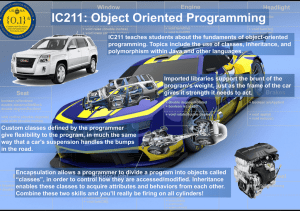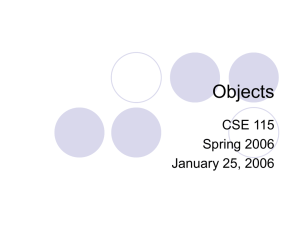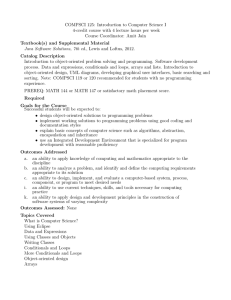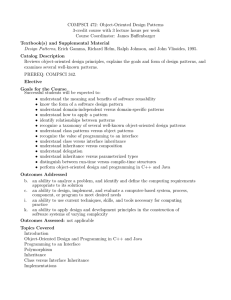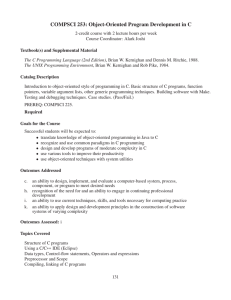Open Issues and Research Directions in Object-Oriented Testing Alessandro Orso Sergio Silva Abstract
advertisement
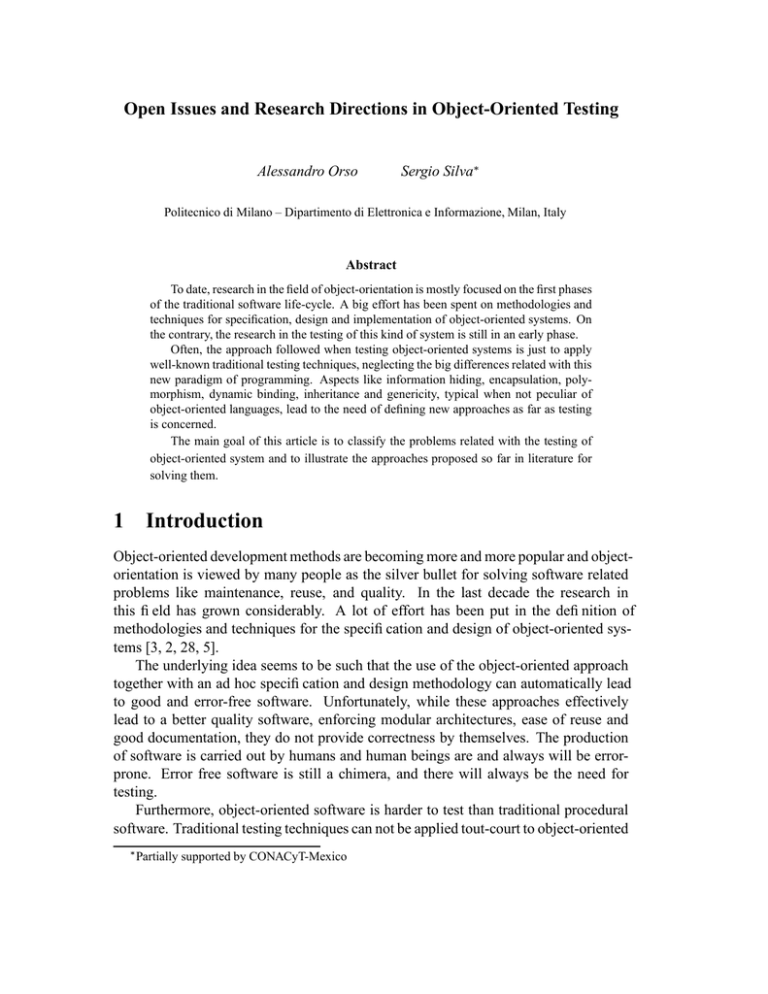
Open Issues and Research Directions in Object-Oriented Testing
Alessandro Orso
Sergio Silva
Politecnico di Milano – Dipartimento di Elettronica e Informazione, Milan, Italy
Abstract
To date, research in the field of object-orientation is mostly focused on the first phases
of the traditional software life-cycle. A big effort has been spent on methodologies and
techniques for specification, design and implementation of object-oriented systems. On
the contrary, the research in the testing of this kind of system is still in an early phase.
Often, the approach followed when testing object-oriented systems is just to apply
well-known traditional testing techniques, neglecting the big differences related with this
new paradigm of programming. Aspects like information hiding, encapsulation, polymorphism, dynamic binding, inheritance and genericity, typical when not peculiar of
object-oriented languages, lead to the need of defining new approaches as far as testing
is concerned.
The main goal of this article is to classify the problems related with the testing of
object-oriented system and to illustrate the approaches proposed so far in literature for
solving them.
1 Introduction
Object-oriented development methods are becoming more and more popular and objectorientation is viewed by many people as the silver bullet for solving software related
problems like maintenance, reuse, and quality. In the last decade the research in
this field has grown considerably. A lot of effort has been put in the definition of
methodologies and techniques for the specification and design of object-oriented systems [3, 2, 28, 5].
The underlying idea seems to be such that the use of the object-oriented approach
together with an ad hoc specification and design methodology can automatically lead
to good and error-free software. Unfortunately, while these approaches effectively
lead to a better quality software, enforcing modular architectures, ease of reuse and
good documentation, they do not provide correctness by themselves. The production
of software is carried out by humans and human beings are and always will be errorprone. Error free software is still a chimera, and there will always be the need for
testing.
Furthermore, object-oriented software is harder to test than traditional procedural
software. Traditional testing techniques can not be applied tout-court to object-oriented
Partially supported by CONACyT-Mexico
software. We need to adapt these techniques, or even to define new techniques, which
are able to cope with the peculiarities of object-orientation.
In this paper, we examine problems introduced by object-orientation in the field of
testing. We illustrate how information hiding, encapsulation, polymorphism, dynamic
binding, and inheritance may lead to new testing problems unseen with traditional software and we present the different approaches found in literature to solve such problems. Section 2 illustrates the aspects of object-oriented languages we consider in this
paper; Section 3 examines the impact of object-oriented features on testing; Sections 4
to 9 analyze the different approaches present in literature to cope with the problems
introduced by object-oriented technology to the testing activities; finally, Section 10
draws some conclusions.
2 Object-orientation aspects
In literature several different definitions of object-orientation can be found and the
term object-oriented is often used to describe a lot of different approaches and/or techniques. Object-oriented technology comprises specific analysis, design and implementation methods. Since this is a paper on testing, and testing is strongly linked to the
implementation, the analysis performed in this paper often refers to object-oriented
specific features of programming languages. In the following we introduce the characteristics we consider as essential for an object-oriented language:
Data Abstraction: Objects are described as implementations of abstract data types
(ADTs). An object-oriented language must support abstract data type definitions. Usually, an ADT definition is called class, while an object is a run-time
instance of a class
Inheritance: Inheritance is a key concept for object-orientation. Object-oriented languages must allow for defining an abstract data type deriving it from an existing
one (either extending it or restricting it)
Polymorphism: Program entities should be permitted to refer to objects of more than
one class, when a hierarchical relationship among these classes exists.
Dynamic binding: Operations applied to a polymorphic variable should be permitted
to have different realizations and the identity of such operations must be resolved
dynamically based on the type of the object the variable is referring to.
In the rest of the article we consider these aspects separately to identify the different
problems every one of them can introduce as far as testing is concerned. In addition,
there are two other aspects that are not purely related to object-orientation, but which
are present in the most common object-oriented languages and which have a heavy
impact on testing:
Genericity: Abstract data types can be defined in a parametric way, i.e., as template
classes whose data structure and operations are defined in terms of classes or
operations specified in the formal parameters list. Generic classes are not used
to generate objects, but to generate new classes
Exception handling: To improve reliability, it is necessary that erroneous conditions
can be recognized by the program and that certain actions are executed in response to the error.
For the sake of brevity, these two topics are not addressed in this paper. The interested reader may refer to the extended version of this article [25].
3 Problems with object-oriented testing
From a technical perspective, object-oriented systems are similar in many respects to
traditional systems. Both at the system level and at the procedure level, the testing
of object-oriented systems is much the same as the testing of traditional systems. In
addition, in object-oriented programming procedures tend to be small, thus testing at
this level tends to be less expensive for object-oriented systems than for traditional
procedural ones. However, the complexity has moved from within code modules to
the interfaces between them, making integration testing necessarily more expensive.
It is in the middle levels of testing that object-oriented systems are most different
from traditionally developed systems. These differences are related with the peculiarities of object-oriented languages illustrated in the previous section. Such topics heavily
impact on testing raising a set of problems only partially present, when not totally absent, in the testing of systems developed with traditional procedural languages. In
this paper we classify the different problems directly related to object-oriented testing
(OOT) into a set of categories. Every category is named after the object-oriented issue
originating the problem when possible, otherwise a specific name is used. We identify
six different areas of possible problems: testing levels, information hiding, shadow
invocations, polymorphism and dynamic binding, conversions, and inheritance.
In the following section the aforementioned problems are specifically addressed
and the solutions for solving them proposed so far in literature are presented.
4 Testing levels
Before starting illustrating the problematics of object-oriented testing we want to spend
some words on the definition of the different testing levels in the object-orientation
field. It is not straightforward to make object-oriented systems fit the traditional testing levels [13]. In fact, in literature there is not a general consensus on what should
be considered a unit and what should be considered a module in an object-oriented
program.
One approach considers the single operation of a class as the elemental unit of
testing, and the whole class as the traditional module. Another approach considers the
testing of a single operation as meaningless, since it does not take into account the state
of the class. For the sake of clarity, in this paper we use the following terminology:
basic unit testing: testing of a single operation of a class (intra-method testing)
unit testing: testing of a class as a whole (intra-class testing)
integration testing: testing of the interaction among classes (inter-class testing)
regression testing: testing of the system as a whole when some change has been performed on one or more classes
A different classification can be found in [29] which also introduces cluster level
testing, where a cluster is considered to be a set of classes providing a particular set of
functionalities.
Please notice that we have defined only the levels of testing affected by the use
of an object-oriented language. We have omitted, for example, system testing, since
the testing of an object-oriented system as a whole can be performed with traditional
techniques.
Many papers analyzed during this work are mostly (when not only) addressing the
unit testing level [18, 11, 4, 33, 9, 12].
5 Information hiding
In traditional procedural programming the basic component is the subroutine and the
testing method for such component is input/output based[14, 34]. In object-oriented
programming things change. The basic component is represented by a class, where a
class is composed by a data structure and a set of operations.
Objects are run-time instances of classes. The data structure defines the state of the
object which is modified by the class operations (methods). In this case, correctness
of an operation is based not only on an input/output relation, but also on the resulting
state. Moreover, the data structure is in general not directly accessible, but can only be
accessed using the class public operations.
Encapsulation and information hiding make it impossible for the tester to check
what happens inside an object during testing. Due to data abstraction there is no visibility of the insight of objects. Thus it is impossible to examine their state. Encapsulation implies the converse of visibility, which in the worst case means that objects can
be more difficult, or even impossible to test.
Encapsulation and information hiding raise the following main problems:
1. Problems in identifying which is the basic component to test.
2. Problems introduced by opacity in the construction of oracles: ingeneral it is not
enough to observe input/output relations, but it is necessary to take into account
the state of objects; on the other hand, the state of an object can be inaccessible,
being observable only through class methods (thus relying on the tested software
itself).
Moreover, the possibility of defining non-instantiable classes (e.g., abstract classes,
generic classes, interfaces) introduces additional problems related to their non straightforward testability.
Figure 1 illustrates an example of information hiding. This simple example shows
how the testing of method checkPressure in isolation is meaningless.
There are fundamentally two approaches proposed in literature for testing objectoriented programs as soon as encapsulation and information hiding are concerned:
class Watcher {
private:
int status;
public:
void checkPressure() {
if(status==1) {...}
else if(status==2) {...}
else ...
}
...
};
Figure 1: An example of information hiding
Breaking encapsulation: it can be achieved either exploiting features of the language (e.g., the C++ friend [30] construct or the Ada child unit [19]) or instrumenting
the code. This approach allows for inspection of private parts of a class. The drawback
in this case is the intrusive character of the approach. An example of this approach can
be found in [22].
Equivalence scenarios: this technique is based on the definition of couples of sequences of method invocations. Such couples are augmented with a tag specifying
whether the two sequences are supposed to leave the object in the same state or not. In
this way it is possible to verify the consistence of the object’s state by comparison of
the resulting states instead of directly inspecting the object’s private parts. Moreover,
in the presence of algebraic specifications this kind of testing can be automated. The
advantage of this approach is that it is less intrusive than the one based on the breaking of encapsulation. However, it is still intrusive, since the analyst needs to augment
the class under test with a method for comparing the state of its instances. The main
drawback of this technique is that it allows for functional testing only. Moreover, the
fault hypothesis is non-specific: different kind of faults may lead to this kind of failure
and many possible faults may not be caught by this kind of testing.
Equivalence scenarios has been introduced in [9]. Another application of this approach
is found in [32]. In this case, when testing a class, states are identified by partitioning data member domains. Then, interactions between methods and state of the object
are investigated. The goal is to identify faults resulting in either the transition to an
undefined state, or the reaching of a wrong state, or the incorrectly remaining in a
state.
6 Shadow invocations
Shadow invocations are operations automatically or implicitly invoked. Such invocations do not appear in the code (i.e., there is no explicit invocation of the operation
in the program). Examples of operations often invoked in this way are constructors,
destructors, and conversion operators.
Shadow invocations introduce problems when constructing scenarios and when
computing coverage values.
class Foo {
...
public:
Foo();
Foo(Foo& f);
~Foo();
...
}
Foo(Foo& f);
Foo();
f1=f;
~Foo();
~Foo();
void bar(Foo f) {
Foo f1;
f1=f;
}
Figure 2: An example of shadow invocations
Figure 2 shows an example of implicit invocations of methods when method bar
is invoked. In this case the two lines of code composing the procedure spread as shown
on the right part of the figure: two Foo’s constructors are invoked and Foo’s destructor
is invoked two times.
So far the only reference to the shadow invocation problem we found is the one
in [1].
7 Polymorphism and dynamic binding
The term polymorphism refers to the capability for a program entity to dynamically
change its type at run-time. This introduces the possibility of defining polymorphic
references (i.e., references that can be bound to objects of different types). In the general case the type of the referred object must belong to a type hierarchy. For example,
in C++ or Java [15] a reference to an object of type A can be assigned an object of any
type B as long as B is either a heir of A or A itself.
Shape
Triangle
Square
Pentagon
...
Circle
Void foo(Shape polygon) {
...
area=polygon.area();
...
}
Figure 3: A simple example of polymorphism
In the presence of polymorphism a reference is assigned both a static and a dynamic
type. The static type of a reference is the type it is given in its declaration, while
the dynamic type of the reference depends on the type of the object the reference is
referring to at run-time.
A feature closely related to polymorphism is dynamic binding. In traditional procedural programming languages, procedure calls are bound statically. Roughly speaking,
the actual code associated to a call is known (i.e., uniquely identified) at link time. In
the presence of polymorphism, the precise object that actually processes a message is
not pre-determined, but it must be an instance of one of a finite number of classes.
More precisely, the actual code invoked as a consequence of a message invocation on
a reference depends on the dynamic type of the reference itself . For example, if class
derived is a sub-class of class parent, the method X (defined in class parent)
is re-defined in class derived, and obj is a reference to an object of type parent,
then when X is invoked on obj it is impossible to statically identify which definition
of X will be executed. In addition, a message sent to a reference can be parametric, and
parameters can be at their turn polymorphic references.
Late binding can easily lead to messages being sent to the wrong object. It can be
very difficult to first identify and then test all the possible bindings. A polymorphic
re-declaration can radically change the semantics of a method and thus fool the clients
of the class it belongs to. Since sub-classing is not inherently sub-typing, dynamic
binding on an erroneous hierarchical chain, can produce undesirable results. Moreover,
even when the hierarchy is well formed, errors are still possible, since the correctness
of a redefined method is not guaranteed by the correctness of the superclass method.
When performing multi-class testing and coverage is concerned, the problem of
defining the sufficient coverage for a polymorphic call arises. Often it is infeasible to
perform an exhaustive testing stressing all the possible combinations “sender of the
message”- “receiver of the message”. It is necessary to define a criterium allowing the
tester to chose only a sufficient/optimal subset of all the possible combinations. The
trade-off here is between the possible infeasibility of the approach and its incompleteness.
Moreover, further concerns are introduced in case classes to be tested belong to a
library instead of belonging to a specific system. Classes built to be used in one specific
system can be tested by restricting the set of possible combinations to the ones identifiable analyzing the code [26]. Re-usable classes need a higher degree of polymorphic
coverage, because such classes will be used in different and sometimes impredictable
contexts. The problems introduced by polymorphism can be summarized as follows:
Due to the combinatorial number of cases to test when testing in the presence of
polymorphism, program based testing may become infeasible.
A new definition of coverage must be provided to cope with the testing of operations on a polymorphic object.
The creation of test sets to cover all possible calls to a polymorphic operation
can not be achieved with a traditional approach.
The presence of polymorphic parameters introduces additional problems for the
creation of test cases.
Figure 3 shows a simple Java example of method invocation on a polymorphic
object. In the proposed example it is impossible to say at compile-time which implementation of the method area is actually called.
Figure 4 illustrate a method invocation (represented in a message sending fashion),
where both the sender and the receiver of the message are polymorphic entities. In
addition, the message has two parameters, also polymorphic. The one represented in
this latter example is the worst situation for testing purposes. As represented in the
figure, the number of possible situations (type of the sender, type of the receiver and
type of parameters) is combinatorial. Moreover in this example we do not take into
account the states of the objects involved. The different objects may behave differently
depending on their state, and this leads to a further explosion of the number of test
cases to be generated.
The exhaustive testing of all the polymorphic run-time bindings is not possible in
general. So far, the underlying idea when testing in the presence of polymorphism is
to identify a criterium for selecting a subset of all the possible combinations of sender,
receiver and parameters.
Message(X, W)
A
B
D
C
E
F
X
W
Y
Z
A---(X, W)--->D
A---(X, Z) --->D
A---(Y, W)--->D
A---(Y, Z) --->D
A---(X, W)--->E
...
A---(X, W)--->F
...
B---(X, W)--->D
...
Figure 4: An example of polymorphic invocation
Problems introduced by polymorphism as far as testing is concerned, have not
been addressed deeply by the different authors working on object-oriented testing. In
the following we describe works developed on this topic: [17] briefly introduces the
problem, but does not provide any technique for addressing it.
The work reported in [21] proposes a partial solution based on sequences of messages. Two sequences are defined: Method Sequence Specification (MtSS), that specifies the order in which the methods of a class can be invoked and Message Sequence
Specification (MgSS), which specifies the causal order in which messages can be sent
to instances of different classes. Both sequences are used for test case generation.
[23] provides a deeper analysis of the problem and illustrates a solution based
on orthogonal arrays. The approach concentrates on message exchanges between objects, considering all the possible combinations of type and status of the sender, of the
receiver and of possible parameters. Such combinations are then reduced using a mathematical method based on orthogonal arrays. This method ensures that all the pairwise
combinations are excercised. The main drawback of the approach is that, because of
its static nature, the method considers all possible combinations (including infeasible
ones).
[27] approaches the problem from a different point of view, addressing polymorphism related issues from the integration testing perspective. This paper introduces a
representation of object-oriented systems defined enriching Objectcharts [7] and then
presents an algorithm that allows the analyst to identify the order in which to perform
class integration testing on a pairwise basis. The article then introduces some heuristics
to reduce the number of test runs.
8 Conversions
Some object-oriented languages allow the programmer to cast objects. In these languages it is possible to perform type conversions which can not be checked at compiletime. Casting errors may cause failures, unless the run-time system provides a way to
catch and handle them. Unfortunately, there are languages (e.g., C++) where this kind
of errors are hardly detected at run-time, thus they often result in program terminaton
with a run-time error.
Test suites should be designed, which take into account possible casting errors.
Stack myStack;
...
Shape shape=myStack.top();
((Circle)shape).radius=28;
...
Figure 5: An example of a risky conversion
Figure 5 shows an example of a possibly wrong casting. If the dynamic type of
object shape is different from Circle a failure occurs at run-time. So far, no authors
addressed the problem of wrong conversions as far as the dynamic testing of objectoriented programs is concerned. Some work has been done both on static analysis
of object-oriented programs in order to achieve static type correctness [6, 20] and on
enrichment of the programming language to make it strongly-typed [8, 31, 24]
9 Inheritance
In traditional procedural programming languages code is structured in subroutines,
which are possibly enclosed in modules. Modules are composed in bottom-up or topdown hierarchies. In this situation, when a subroutine has been tested and accepted
there is no need to re-test it.
Object-oriented programs are structured in classes and inheritance is the fundamental relationship among classes. Inheritance is probably the most powerful feature
provided by object-oriented languages. By taking advantage of the inheritance mechanism, programmers may create new classes that extend existing ones. As a result,
classes defined using object-oriented languages are organized in a hierarchy (usually
called the is-a hierarchy) originated by the inheritance relationship. Object-oriented
languages may provide single or multiple inheritance. Object-oriented languages providing single inheritance allows a class to inherit from a single parent class. Conversely, in Object-oriented languages providing multiple inheritance each class may
inherit from more than one parent.
The inheriting derived classes are allowed to perform one or more of the following
operations: override (i.e., redefine) the inherited methods by providing a different implementation which better fits their needs, add new features to the inheriting class, and
eliminate some of the features provided by their super class(es). In this paper we refer
to the following inheritance schemes:
Strict inheritance : in this schema, methods can be added in subclasses
Subtyping inheritance : this schema extends the strict inheritance giving subclasses
the possibility of overriding (i.e., redefining) methods inherited from their superclass(es)
Subclassing inheritance : In addition to the features provided by Subtyping inheritance, in this schema it is possible to eliminate methods from the superclass(es)
In most object-oriented languages, inheritance is a mechanism allowing for achieving two goals: code reuse and definition of type/subtype relationships. In the first case,
the use of inheritance raises the following issues:
Initialization problems: it is necessary to test whether a subclass specific constructor
(i.e., the method in charge for initializing the class) is correctly invoking the
constructor of the parent class.
Semantic mismatch: in case of subtyping inheritance, methods in the subclasses may
have a different semantics and thus they may need different test suites [29].
Moreover, multiple inheritance and repeated inheritance can lead to particular
cases of semantic mismatch related to name clashing and/or misnaming.
Possibility of test reduction: can we trust features of classes we inherit from, or should
we re-test derived classes from scratch? An optimistic view claims that only little
or even no test is needed for classes derived from thoroughly tested classes [4].
A deeper and more realistic approach argues that methods of derived classes
need to be re-tested in the new context [16]. An inherited method can behave
erroneously due to either the derived class having redefined members in an inappropriate way or the method itself invoking a method redefined in the subclass.
Re-use of test cases: it is possible to use the same test cases generated for the base
class during the testing of the derived class? If this is not possible, can we at
least find a way of partially reusing such test cases? [9, 10]
Inheritance correctness: can we test whether the inheritance is truly expressing an
IS-A relationship or are we just in presence of code reuse? Is this kind of test
meaningful in absence of specifications for the class(es) under test? This issue
is in some way related to the misleading interpretation of inheritance as a way of
both reusing code and defining subtypes.
Testing of abstract classes: abstract classes can not be instantiated and thus can not
be thoroughly tested. Only classes derived from abstract classes can be actually
tested, but errors can be present also in the super (abstract) class
Figure 6 shows an example of inheritance. Questions which may arise looking
at the example are whether should we retest the method Circle::moveTo() and
whether is it possible to reuse test sets created for the class Shape to test the class
Circle.
There are different approaches proposed in literature for coping with the testing
problems introduced by inheritance. A first, simplistic approach starts from the idea
that inherited code needs only minimal testing. Techniques addressing the problem
from a more theoretical point of view have also been proposed and they can be divided
class Shape {
private:
Point referencePoint;
public:
void erase();
virtual float area()=0;
void moveTo(Point p);
...
};
class Circle : public Shape {
private:
int radius;
public:
erase();
float area();
...
};
Figure 6: An example of inheritance
in two main classes: Approaches based on the flattening of classes, and approaches
based on incremental testing.
The former ones are based on the testing of subclasses as if every inherited feature had been defined in the subclass itself (i.e., flattening the hierarchy tree). The
advantage of this kind of approach is related to the possibility of reusing test cases
previously defined for the superclass(es) for the testing of the flattened subclass (obviously, adding new test cases when needed due to the addition of new features to the
subclass). Redundancy is the price to be paid when following such approach. All
features are re-tested in any case without any further consideration.
The latter ones start from the idea that both re-testing all inherited features and not
re-testing any inherited features are wrong approaches for opposite reasons. Only a
subset of inherited features needs to be re-tested in the new context of the subclass.
The approaches differ in the way this subset is identified.
In the following we briefly describe the most relevat works developed on this topic.
[11] states that methods provided by a parent class (which has already been tested) do
not require heavy testing. This viewpoint is usually shared by practitioners, committed
more to the quick results than to theoretical foundations.
An algorithm for selecting the methods that need to be re-tested in subclasses is
presented in [4]. A similar, but more rigorous approach is presented in [16]. This latter
paper starts defining a taxonomy of the kinds of attribute in a derived class depending
both on whether they are added, or redefined, or left untouched and on the kind of dependencies with other methods belonging to the same class; the approach presented is
based on the definition of a testing history for each class under test, on the construction
of a call graph to represent intra/inter class interactions, and on an algorithm allowing,
starting from the testing history and from the graph, for identifying which attributes
have to be re-tested, which test cases can be re-used, and which attributes require new
test cases.
Alternative approaches are based on the flattening of the class structure. [12]
presents a technique that besides flattening the class structure, re-uses specifications of
the parent classes. Another flattening oriented approach is presented in [29], this paper
presents a technique based on the flattening of subclasses performed avoiding to test
“unaffected” methods (methods not redefined and neither invoking redefined methods,
nor using redefined attributes).
Finally, another approach for testing in the presence of inheritance is presented
in [21]. In this case the goal is different from the ones of the previously presented
papers. The focus of the work is on the testing of the consistency of the hierarchical
relationships based on class’ histories.
10 Conclusions
Although there is an increasing attention to the problematic of OOT, there are still
many topics far to be covered. The main research effort is focused on the definition of
object-oriented notations and methodologies, while little attention is paid on the testing
of object-oriented systems. Unfortunately, object-orientation is not the silver bullet allowing designers and developers to produce error-free software, and good specification
and design techniques do not eliminate the need for testing.
Object-oriented systems need to be tested just as much as (when not more than)
systems developed using traditional procedural languages. Object-orientation peculiarities introduce new kind of problems as far as testing is concerned, and thus new
ad-hoc testing techniques need to be defined (or at least traditional testing techniques
need to be adapted). Moreover, concepts like adequacy and coverage, must be revisited
to adapt them to the new paradigm represented by object-orientation.
So far, literature on object-oriented testing is still limited and there are still many
aspects only uncomplitely addressed when not totally neglected. Aspects like information hiding, inheritance, polymorphism, and dynamic binding need to be specifically
addressed and an appropriate error taxonomy must be defined, which allows for designing appropriate test cases. Traditional error taxonomies do not cope with brand
new errors introduced by object-oriented features. Besides, there is only poor statistical information on which are the most frequent errors and on costs of error detection
and removal.
References
[1] S. Barbey, M. Ammann, and A. Strohmeier. Open issues in testing Object Oriented software. In K. F. (Ed.), editor, ECSQ ’94 (European Conference on Software Quality), pages 257–267, vdf Hochschulverlag AG an der ETH Zürich,
Basel, Switzerland, October 1994. Also available as Technical Report (EPFLDI-LGL No 94/45).
[2] G. Booch. Object Oriented Design. Benjamin/Cummings Publ., USA, 1991.
[3] G. Booch, I. Jacobson, and J. Rumbaugh. Unified Modeling Language User
Guide. Addison-Wesley, 1997.
[4] T. J. Cheatham and L. Mellinger. Testing Object-Oriented Software Systems.
In Proceedings of the Eighteenth Annual Computer Science Conference, pages
161–165. ACM, Feb. 1990.
[5] P. Coad and E. Yourdon. Object-Oriented Analysis. Prentice Hall, London, 2
edition, 1991.
[6] A. Coen-Prosini, L. Lavazza, and R. Zicari. Assuring type safety of objectoriented languages. Journal of Object-Oriented Programming, 5(9):25–30,
February 1994.
[7] D. Coleman, F. Hyes, and S. Bear. Introducing objectcharts or how to use statecharts in object-oriented design. IEEE Transactions on Software Engineering,
18(1):9–18, January 1992.
[8] W. Cook. A proposal for making eiffel type-safe. The Computer Journal, 32(4),
1989.
[9] R. Doong and P. Frankl. The astoot approach to testing object-oriented programs.
ACM Transactions on Software Engineering and Methodology, 3(2):101–130,
April 1994.
[10] R.-K. Doong and P. G. Frankl. Case Studies on Testing Object-Oriented Programs. In Proceedings of the Symposium on Testing, Analysis, and Verification
(TAV4), pages 165–177, Victoria, CDN, Oct. 1991. ACM SIGSOFT, acm press.
[11] S. P. Fiedler. Object-Oriented Unit Testing. HP Journal, 40(3):69–74, April
1989.
[12] R. Fletcher and A. S. M. Sajeev. A framework for testing object-oriented software using formal specifications. In A. Strohmeier, editor, Reliable Software
Technologies, number 1088 in Lecture Notes in Computer Science, pages 159–
170. Springer, 1996.
[13] C. Ghezzi, M. Jazayeri, and D. Mandrioli. Fundamentals of Software Engineering. Prentice-Hall, Englewood Cliffs N.J., 1991.
[14] J. B. Goodenough and S. L. Gerhart. Toward a theory of test data selection. IEEE
Transactions on Software Engineering, SE-1(2):156–173, June 1975.
[15] J. Gosling, B. Joy, and G. Steele. The Java Language Specification. AddisonWesley, Inc., 1996.
[16] M. J. Harrold, J. D. McGregor, and K. J. Fitzpatrick. Incremental Testing of
Object-Oriented Class Structures. In Proceedings of the 14th International Conference on Software Engineering (ICSE’92), pages 68–80, Melbourne/Australia,
May 1992.
[17] M. J. Harrold and G. Rothermel. Performing data flow testing on classes. In 2nd
ACM-SIGSOFT Symposium on the foundations of software engineering, pages
154–163. ACM-SIGSOFT, December 1994.
[18] N. Hunt. Unit testing. Journal of Object-Oriented Programming, pages 18–23,
February 1996.
[19] ISO/IEC. International Standard ISO/IEC 8652:1995(E). Int. Organization for
Standarization - Int. Electrotechnical Commission, 1995.
[20] R. Jones. Extended type checking in eiffel. Journal of Object-Oriented Programming, 5(2):59–62, 1992.
[21] S. Kirani. Specification and Verification of Object-Oriented Programs. PhD
thesis, University of Minnesota, Minneapolis, Minnesota, December 1994.
[22] I. I. P. Ltd. Achieving testability when using ada packaging and data hiding
methods. Web page, 1996. http://www.teleport.com/ qcs/p824.htm.
[23] J. McGregor and T. Korson. Testing of the polymorphic interactions of classes.
Technical Report TR-94-103, Clemson University, 1994.
[24] B. Meyer. Object-oriented Software Construction. Prentice Hall, New York,
N.Y., second edition, 1997.
[25] A. Orso and S. Silva. Open Issues and Research Directions in Object-Oriented
Testing. Technical Report 98.5, Politecnico di Milano, Dipartimento di Elettronica e Informazione, February 1998.
[26] H. D. Pande and B. G. Ryder. Static type determination for c++. Technical Report LCSR-TR-197-A, Rutgers University, Lab. of Computer Science Research,
October 1995.
[27] A. Paradkar. Inter-Class Testing of O-O Software in the Presence of Polymorphism. In Proceedings of CASCON96, Toronto, Canada, November 1996.
[28] J. Rumbaugh, M. Blaha, W. Premerlani, F. Eddy, and W. Lorensen. ObjectOriented Modeling and Design. Prentice Hall, Englewood Cliffs, 1991.
[29] M. Smith and D. Robson. A framework for testing object-oriented programs.
Journal of Object-Oriented Programming, 5(3):45–53, June 1992.
[30] B. Stroustrup. The C++ Programming Language. Addison-Wesley, 2nd edition,
1994.
[31] B. Stroustrup and D. Lenkov. Run-time type identification for C++ (revised). In
Proc USENIX *C Conference, Aug. 1992.
[32] C. D. Turner and D. J. Robson. The state-based testing of object-oriented programs. In International Conference on Software Maintenance, pages 302–310.
IEEE Society Press, September 1993.
[33] C. D. Turner and D. J. Robson. The testing of object-oriented programs. Technical Report TR-13/92, University of Durham, Durham, UK, February 1993.
[34] E. J. Weyuker and T. J. Ostrand. Theories of program testing and the application of revealing subdomains. IEEE Transactions on Software Engineering,
SE-6(3):236–246, May 1980.
Corresponding author:
Alessandro Orso
Politecnico di Milano - Dipartimento di Elettronica e Informazione
Piazza Leonardo da Vinci, 32
I-20133, Milan, ITALY
Tel. +(39)(2)2399 3638; Fax. +(39)(2)2399 3411
e-mail: orso@elet.polimi.it
